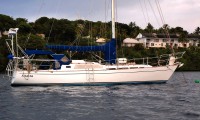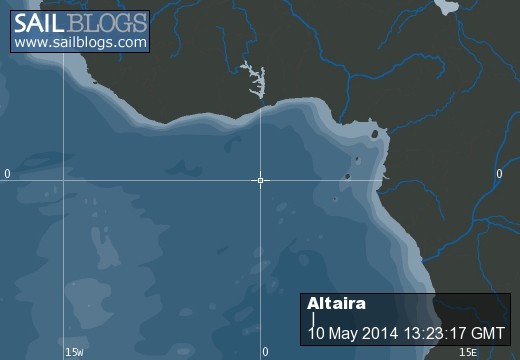Profile

Who: Kimball Corson. Text and Photos not disclaimed or that are obviously not mine are copyright (c) Kimball Corson 2004-2016
Port: Lake Pleasant, AZ
Altaira Wandering the Oceans
Favorites
- 7 Seas Cruising Association
- American Sailing Association
- Buoyweather Service
- CDC Traveler's Heath Advisories
- Cruiser Log venue
- Cruisers Forum
- Cruising Club of America
- Cruising Resources
- Cruising World Magazine
- Earthrace World Record
- Economic and Financial Indicators
- Economist Magazine
- Equipmment and Boat Reviews
- Float Plan Form
- Greenpeace Int'l
- Grib File Access
- Heavy Weather Sailing
- IMS Certificates
- Inland Travel: Expedia
- Intrade Prediction Markets
- Latitude 38
- London Financial Times
- Marine Books and Charts
- Marine Radios
- Nature Conservancy for Oceans
- New York Times
- NOAA Hurricane Analysis
- NOAA Weather Forecasts
- Noonsite, World Cruisng Info
- Ocean Cruising Club
- Overseas Mail Forwarding Services
- Practical Sailor Magazine
- RGE Economic Monitor
- Sail Gear Source I
- Sail Gear Source II
- Sail Gear Source III
- Sail Gear Source IV
- Sailboat Selection for Offshore Use
- Sailboats for Sale
- Sailing Items Sources Links
- SailMail (Marine Radio)
- Sailnet Sailing Information
- Seeking Alpha
- Tide & Current Program
- Tide Prediction Programs
- Tides & Currents
- TruthDig in the News
- U.S. Sailing Association
- Univ of Chicago Law Faculty Blog
- US State Dept Travel Advisories
- Voyage Planning (with pilot charts)
- Wall Street Journal
- Washington Post
- Weather.com
- Weather: MagicSeaweed
- Weather: Wetsand
- WinLink (Ham Radio)
- World Clock + Time Zones
09 April 2018 | Pago Pago, American Samoa
10 March 2018 | Pago Pago, American Samoa
10 March 2018 | Pago Pago, American Samoa
10 March 2018 | Pago Pago, American Samoa
22 August 2017 | Pago Pago, American Samoa
22 August 2017 | Pago Pago, American Samoa
22 August 2017 | Pago Pago, American Samoa
22 August 2017 | Pago Pago, American Samoa
22 August 2017 | Pago Pago, American Samoa
22 August 2017 | Pago Pago, American Samoa
22 August 2017 | Pago Pago, American Samoa
22 August 2017 | Pago Pago, American Samoa
22 August 2017 | Pago Pago, American Samoa
22 August 2017 | Pago Pago, American Samoa
22 August 2017 | Pago Pago, American Samoa
22 August 2017 | Pago Pago, American Samoa
22 August 2017 | Pago Pago, American Samoa
22 August 2017 | Pago Pago, American Samoa
22 August 2017 | Pago Pago, American Samoa
09 August 2017 | Pago Pago, American Samoa
Why Banks Do Not Create and Destroy Money by Lending
30 August 2016 | Pago Pago, American Samoa
Kimball Corson

As Chris Cook explains, US banks do not create money by making loans which money is then destroyed when those loans are paid back, the conventional view on money creation. What actually happens is when a bank makes a loan, it "credits" the loan amount in dollars to the borrower's demand account as additional dollars the borrower has to spend and the credit is then mistakenly viewed as a part of the money supply. In truth, it is only a credit amount denominated in dollars until it is actually spent by the borrower. Then it becomes additional dollars of demand flowing against goods and services which the Fed has to then fund with expansive open market operations or QE. Only the Fed creates and destroys money per se, not banks. Banks are simply in the credit business. This means Banks do not create and destroy money by lending, and this is a shocking conclusion with far reaching implications.
When a bank loan is paid back, the Fed should then reverse the process, but it usually does not, seeking to encourage further investment spending instead by keeping that money in circulation. Because of income inequality and now differential propensities to spend and hold money as wealth, we then have liquidity preferences by the rich and wealthy which have created a liquid trap because much of that now "excess" money in circulation is simply hoarded by the wealthy and not spent on consumption or real investment, preventing undue inflationary pressure and slowing the velocity of money, as the quantity of it is increased by the Fed.
The similar thing happens when the federal government "borrows." It does not crowd out private borrowing for investment to get that money because it is not really selling a competing debt product per se. It is really just acquiring a credit to spend and have the Fed fund once the dollar amount enters the flow of money against goods and services. it is really selling a consol or stock share in the USA for credit which pays the equivalent of a fixed dividend and is redeemable by the USA according to a schedule. The public debt is a fiction. There is no link at all between revenues of the government and its expenditures.
The idea government borrows dollars from the public by selling treasuries and then spends that money is wrong. For example, taxes and borrowing proceeds paid in cash result in that cash being destroyed and removed from circulation. Again, there is no real link between government revenue and government expenditure. Like banks, the government can create its own credit for its expenditures which is not money until it moves into circulation and must be funded by the Fed. Such credit is often simply a credit against taxes owing to become due in the future. The idea there is this massive public debt that must be repaid is nonsense. The Fed similarly funds government credit after it becomes federal dollar expenditure.
Only the Fed can create money because only the Fed acquires or buys something in doing so with actual money. Banks don't do that. Like the government, they deal only in credit and buy or acquire nothing to create that credit per se. although the government uses its credit to then buy things just like borrowers do.
Most simply don't understand these matters or the distinction between credit and money, including most officials at the fed and in government. Money creation and its supply are affirmatively misunderstood. The consequences for policy are considerable.
When a bank loan is paid back, the Fed should then reverse the process, but it usually does not, seeking to encourage further investment spending instead by keeping that money in circulation. Because of income inequality and now differential propensities to spend and hold money as wealth, we then have liquidity preferences by the rich and wealthy which have created a liquid trap because much of that now "excess" money in circulation is simply hoarded by the wealthy and not spent on consumption or real investment, preventing undue inflationary pressure and slowing the velocity of money, as the quantity of it is increased by the Fed.
The similar thing happens when the federal government "borrows." It does not crowd out private borrowing for investment to get that money because it is not really selling a competing debt product per se. It is really just acquiring a credit to spend and have the Fed fund once the dollar amount enters the flow of money against goods and services. it is really selling a consol or stock share in the USA for credit which pays the equivalent of a fixed dividend and is redeemable by the USA according to a schedule. The public debt is a fiction. There is no link at all between revenues of the government and its expenditures.
The idea government borrows dollars from the public by selling treasuries and then spends that money is wrong. For example, taxes and borrowing proceeds paid in cash result in that cash being destroyed and removed from circulation. Again, there is no real link between government revenue and government expenditure. Like banks, the government can create its own credit for its expenditures which is not money until it moves into circulation and must be funded by the Fed. Such credit is often simply a credit against taxes owing to become due in the future. The idea there is this massive public debt that must be repaid is nonsense. The Fed similarly funds government credit after it becomes federal dollar expenditure.
Only the Fed can create money because only the Fed acquires or buys something in doing so with actual money. Banks don't do that. Like the government, they deal only in credit and buy or acquire nothing to create that credit per se. although the government uses its credit to then buy things just like borrowers do.
Most simply don't understand these matters or the distinction between credit and money, including most officials at the fed and in government. Money creation and its supply are affirmatively misunderstood. The consequences for policy are considerable.
Comments
| Vessel Name: | Altaira |
| Vessel Make/Model: | A Fair Weather Mariner 39 is a fast (PHRF 132), heavily ballasted (43%), high-aspect (6:1), stiff, comfortable, offshore performance cruiser by Bob Perry that goes to wind well (30 deg w/ good headway) and is also good up and down the Beaufort scale. |
| Hailing Port: | Lake Pleasant, AZ |
| Crew: | Kimball Corson. Text and Photos not disclaimed or that are obviously not mine are copyright (c) Kimball Corson 2004-2016 |
| About: | |
| Extra: |
Altaira's Photos - Main
No items in this gallery.
Profile

Who: Kimball Corson. Text and Photos not disclaimed or that are obviously not mine are copyright (c) Kimball Corson 2004-2016
Port: Lake Pleasant, AZ
Altaira Wandering the Oceans
Favorites
- 7 Seas Cruising Association
- American Sailing Association
- Buoyweather Service
- CDC Traveler's Heath Advisories
- Cruiser Log venue
- Cruisers Forum
- Cruising Club of America
- Cruising Resources
- Cruising World Magazine
- Earthrace World Record
- Economic and Financial Indicators
- Economist Magazine
- Equipmment and Boat Reviews
- Float Plan Form
- Greenpeace Int'l
- Grib File Access
- Heavy Weather Sailing
- IMS Certificates
- Inland Travel: Expedia
- Intrade Prediction Markets
- Latitude 38
- London Financial Times
- Marine Books and Charts
- Marine Radios
- Nature Conservancy for Oceans
- New York Times
- NOAA Hurricane Analysis
- NOAA Weather Forecasts
- Noonsite, World Cruisng Info
- Ocean Cruising Club
- Overseas Mail Forwarding Services
- Practical Sailor Magazine
- RGE Economic Monitor
- Sail Gear Source I
- Sail Gear Source II
- Sail Gear Source III
- Sail Gear Source IV
- Sailboat Selection for Offshore Use
- Sailboats for Sale
- Sailing Items Sources Links
- SailMail (Marine Radio)
- Sailnet Sailing Information
- Seeking Alpha
- Tide & Current Program
- Tide Prediction Programs
- Tides & Currents
- TruthDig in the News
- U.S. Sailing Association
- Univ of Chicago Law Faculty Blog
- US State Dept Travel Advisories
- Voyage Planning (with pilot charts)
- Wall Street Journal
- Washington Post
- Weather.com
- Weather: MagicSeaweed
- Weather: Wetsand
- WinLink (Ham Radio)
- World Clock + Time Zones
